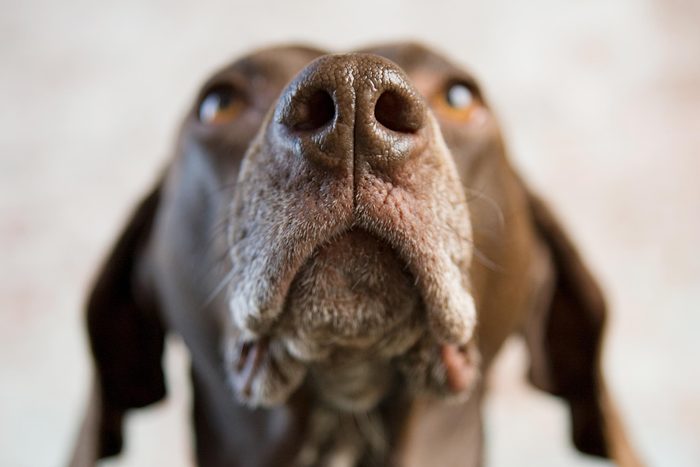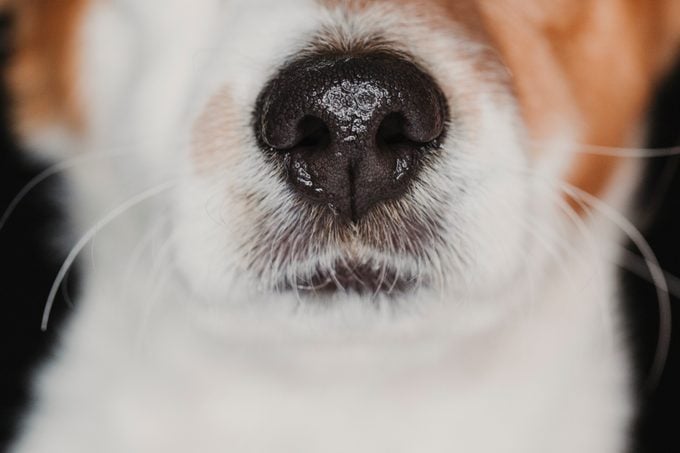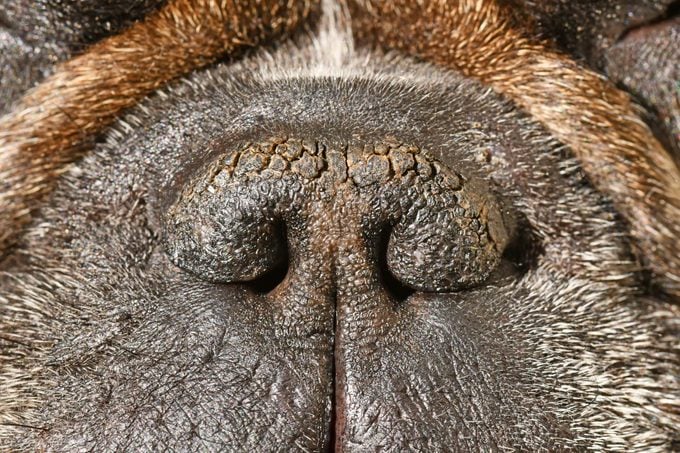Why Are Dogs’ Noses Wet? 5 Reasons, According to a Vet
Updated: Apr. 17, 2024

Everything about a dog is warm and cuddly … except for its nose! Here’s why dog noses tend to be wet and what it could mean about your pup’s health.
All pet parents have been there: You’re cuddling with your dog, getting all warm and snuggly … until you’re suddenly startled by a cold, wet nose on your bare skin. Ack! That cuddle isn’t relaxing as it once was, and now, you’re probably wondering, Why are dogs’ noses wet?
While you’ve likely heard a few theories about this canine phenomenon, they might not have been from reliable sources. Well, I’m a veterinarian with more than 25 years of experience, and I combined my knowledge about this dog fact with the latest scientific research to bring you the definitive answer. Ahead, you’ll find out exactly why dogs’ noses are wet—and whether you should be concerned when they’re not.
Get Reader’s Digest’s Read Up newsletter for more pets, humor, cleaning, travel, tech and fun facts all week long.
Why are dogs’ noses wet?

It’s not random! Two main canine traits explain why dogs’ noses are wet—their incredibly strong sense of smell and their fur-covered bodies—though other factors can account for those cold, wet noses too.
To enhance their sense of smell
Dogs’ noses are wet mainly because wet noses do a better job of smelling than dry noses, and since dogs use their noses more than their eyes to navigate their way through the world, this is extremely important. The canine sense of smell is incredible—it is said to be 10,000 to 100,000 times better than ours. When a dog sniffs an interesting patch of ground, they are not only able to get information about what is currently going on but also about what happened in the past. Search-and-rescue dogs are a good example of this: They can use odor gradients to figure out which direction a person traveled, since the newer odors are stronger than the older odors. Imagine what our sense of sight would be like if we could see what used to be there in addition to what is there right now!
To stay cool
A wet nose has another benefit for dogs—it can keep them cool. Humans primarily cool down when sweat evaporates off their skin, but this isn’t the case for dogs. While evaporation still comes into play, it’s mostly through panting, though that wet nose plays a small role too. A dog’s nose and paw pads are the only two parts of a dog’s body that produce the type of sweat involved in cooling. Sweat glands kick into gear whenever a dog gets too warm, so a dog that is active or exposed to high external temperatures will probably have a wet nose.
Mucus
The inside of a dog’s nose produces a thin, watery mucus that captures smell molecules from the air they breathe in. A little of this mucus will drip out from time to time and make the front part of a dog’s nose wet. Occasionally seeing a bit of clear fluid under your dog’s nostrils is normal and nothing to worry about.
Licking
Dogs have extraordinarily long and flexible tongues that they can use to clean off their noses. You can imagine that a moist nose that is snuffling through all sorts of interesting things tends to collect a lot of dirt and debris. Using your tongue to wipe your nose may sound gross (especially since dogs lick you with it too!), but it’s an effective way for dogs to keep their noses clean, wet and functioning well.
Sticking their noses in wet places
Dogs may also stick their noses in wet places, like damp grass or their water bowl. The wet nose that results is likely an unintended consequence of these types of behaviors, but the extra water will still help them smell better and stay cool.
Why are dogs’ noses always cold?
Dog noses feel cold to us because they are cold. A study published in the Journal of Thermal Biology in 2017 found that the noses of “adult, alert and comfortable dogs” were on average about 9 degrees colder than the temperature of their surroundings, but this temperature differential can go as high as 25 degrees! Just imagine you and your dog are hanging out in a comfortable room that is heated to 70 degrees Fahrenheit. Your dog’s nose could be as cold as 45 degrees, which will feel downright frigid against your skin. The authors of the study theorize that the “cold state is the operating state” for a dog’s nose, perhaps so they can better sense warm things in their environment.
What does it mean when a dog’s nose is dry?

It could mean nothing … or something. But the most important thing is not to panic if your dog’s nose is dry or warm. I have examined thousands of healthy dogs, and I can tell you that it’s perfectly normal for a dog’s nose not to be cold and wet from time to time—for example, a dog that’s in my office and about to get a vaccine. A dog that is a little chilly will probably not produce sweat on its nose. It also may not have recently licked its nose or taken a drink of water, which could account for the dryness.
Additionally, you might not be the most reliable gauge of whether your dog’s nose is actually cool. A study published in the Canadian Journal of Veterinary Research in 2021 showed that people are quite bad at using their sense of touch to determine if a dog’s nose is warm; it might be cooler than you think! If your dog’s nose is dry and feels warm to you, take a step back and look at the big picture. When you don’t notice any other symptoms of illness, you probably don’t have anything to worry about.
On the other hand, some health problems can cause dogs to develop a dry nose, but other clinical signs, like the ones listed below, are usually present too. Here’s what you should watch out for:
Fever
A dog that has a fever may have a dry nose, but it will often also be lethargic, have a poor appetite and may shiver. Additional clinical signs, such as coughing or vomiting, will depend on the specific condition that is causing the fever. If you think your dog might have a fever, use a thermometer to get an accurate measurement of your dog’s body temperature. Depending on the type of thermometer for dogs that you choose, it can be used near unfurred skin, in the ear or in the rectum.
Dehydration
Any condition that leads to dehydration can make a dog’s nose dry out. If the cause is as simple as a temporary lack of access to water, giving your dog something to drink should take care of the problem, but health problems can be to blame too. Kidney disease and diabetes make dogs urinate more than normal, which can subsequently make them dehydrated. Diseases that result in vomiting or diarrhea can also lead to this issue. These may include gastroenteritis, bacterial or viral infections, gastrointestinal parasites, inflammatory bowel disease and pancreatitis, to name a few.
Heat exhaustion or heat stroke
A dog that is developing heat exhaustion or heat stroke may also have a dry nose, but more serious symptoms will quickly become evident as its condition worsens. Signs include excessive panting, drooling, gums that are bright red, a high heart rate, vomiting, diarrhea, disorientation, weakness, collapse and seizures.
Diseases affecting the skin of the nose
A few health problems directly affect the skin of the nose and can make it dry. For example, keratoconjunctivitis sicca can lead to dryness that affects one or both sides of a dog’s nose; with this condition, one or both eyes will also usually be red and painful and have some abnormal drainage. And the most obvious signs of discoid lupus erythematosus (DLE) include skin lesions on the bridge of a dog’s nose and a loss of color and texture on the hairless part of a dog’s nose. These symptoms are usually more noticeable than any nose dryness that a dog has.
When should I bring my dog to the vet?
Don’t use the wetness or temperature of a dog’s nose to determine if your dog needs to be seen by a veterinarian. A healthy dog can have a warm, dry nose, and a sick dog can have a cool, wet one, so pet parents need to look to a dog’s overall condition for answers. As is always the case, call your veterinarian for advice if you have any questions about your dog’s health or well-being.
Hopefully, I’ve provided you with some good answers to the question “Why are dogs’ noses wet?” And now, you might be wondering why a dog would put its wet nose on you in the first place. Two reasons come to mind:
- It’s just an accident when your pup is coming in close for some cuddles.
- Your dog has learned it’s a surefire way to get a reaction out of you!
Sources:
- Frontiers in Veterinary Science: “When the Nose Doesn’t Know: Canine Olfactory Function Associated with Health, Management, and Potential Links to Microbiota”
- Animals (Basel): Canine Olfaction: “Physiology, Behavior, and Possibilities for Practical Applications”
- Journal of Thermal Biology: “Rhinarium temperature dynamics in domestic dogs”
- Scientific Reports: “Dogs can sense weak thermal radiation”
- Canadian Journal of Veterinary Research: “The accuracy of tactile assessment of canine nose temperature to identify rectal hyperthermia and hypothermia in dogs presenting on an emergency basis”
Why trust us
At Reader’s Digest, we’re committed to producing high-quality content by writers with expertise and experience in their field in consultation with relevant, qualified experts. For this piece on why dogs’ noses are wet, Jennifer Coates, DVM, tapped her experience as a veterinarian with more than 25 years of professional experience, and then veterinarian Amy Attas, VMD, founder of City Pets and author of Pets and the City: True Tales of a Manhattan House Call Veterinarian, gave it a rigorous review to ensure that all information is accurate and offers the best possible advice to readers. We verify all facts and data, back them with credible sourcing and revisit them over time to ensure they remain accurate and up to date. Read more about our team, our contributors and our editorial policies.




